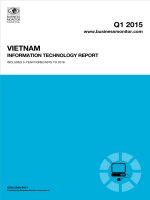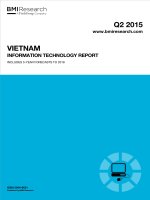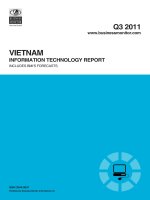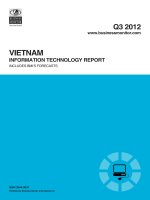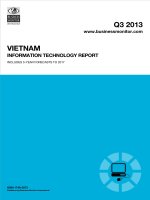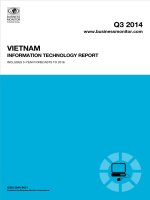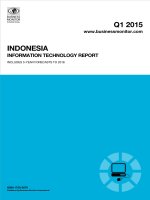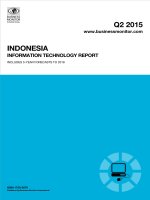Israel information technology report q3 2015
Bạn đang xem bản rút gọn của tài liệu. Xem và tải ngay bản đầy đủ của tài liệu tại đây (372.54 KB, 82 trang )
Q3 2015
www.bmiresearch.com
ISRAEL
INFORMATION TECHNOLOGY REPORT
INCLUDES 5-YEAR FORECASTS TO 2019
ISSN 1752-4245
Published by:BMI Research
Israel Information Technology Report Q3
2015
INCLUDES 5-YEAR FORECASTS TO 2019
Part of BMI’s Industry Report & Forecasts Series
Published by: BMI Research
Copy deadline: April 2015
BMI Research
Senator House
85 Queen Victoria Street
London
EC4V 4AB
United Kingdom
Tel: +44 (0) 20 7248 0468
Fax: +44 (0) 20 7248 0467
Email:
Web:
© 2015 Business Monitor International Ltd
All rights reserved.
All information contained in this publication is
copyrighted in the name of Business Monitor
International Ltd, and as such no part of this
publication may be reproduced, repackaged,
redistributed, resold in whole or in any part, or used
in any form or by any means graphic, electronic or
mechanical, including photocopying, recording,
taping, or by information storage or retrieval, or by
any other means, without the express written consent
of the publisher.
DISCLAIMER
All information contained in this publication has been researched and compiled from sources believed to be accurate and reliable at the time of
publishing. However, in view of the natural scope for human and/or mechanical error, either at source or during production, Business Monitor
International Ltd accepts no liability whatsoever for any loss or damage resulting from errors, inaccuracies or omissions affecting any part of the
publication. All information is provided without warranty, and Business Monitor International Ltd makes no representation of warranty of any kind
as to the accuracy or completeness of any information hereto contained.
Israel Information Technology Report Q3 2015
CONTENTS
BMI Industry View ............................................................................................................... 7
SWOT .................................................................................................................................... 9
IT SWOT .................................................................................................................................................. 9
Political ................................................................................................................................................. 11
Economic ............................................................................................................................................... 12
Operational Risk ..................................................................................................................................... 13
Industry Forecast .............................................................................................................. 15
IT Market ............................................................................................................................................... 15
Table: IT Industry - Historical Data And Forecasts (Israel 2012-2019) . . . . . . . . . . . . . . . . . . . . . . . . . . . . . . . . . . . . . . . . . . . . . . . . . . . . . . . . . . . . . . . . . . . . . . . . . . . . . . . 15
Macroeconomic Forecasts ............................................................................................... 20
Economic Analysis ................................................................................................................................... 20
Expenditure Breakdown .......................................................................................................................... 21
Table: Economic Activity (Israel 2010-2019) . . . . . . . . . . . . . . . . . . . . . . . . . . . . . . . . . . . . . . . . . . . . . . . . . . . . . . . . . . . . . . . . . . . . . . . . . . . . . . . . . . . . . . . . . . . . . . . . . . . . . . . . . . 25
Industry Risk Reward Index ............................................................................................. 26
Middle East And Africa Risk/Reward Index - Q315 ........................................................................................ 26
Table: MEA IT Risk/Reward Index - Q315 . . . . . . . . . . . . . . . . . . . . . . . . . . . . . . . . . . . . . . . . . . . . . . . . . . . . . . . . . . . . . . . . . . . . . . . . . . . . . . . . . . . . . . . . . . . . . . . . . . . . . . . . . . . . . 29
Market Overview ............................................................................................................... 30
Hardware ............................................................................................................................................. 30
Software ............................................................................................................................................... 35
Services ................................................................................................................................................ 39
Industry Trends And Developments ................................................................................ 42
Regulatory Development .................................................................................................. 48
Table: IT Regulatory Authorities . . . . . . . . . . . . . . . . . . . . . . . . . . . . . . . . . . . . . . . . . . . . . . . . . . . . . . . . . . . . . . . . . . . . . . . . . . . . . . . . . . . . . . . . . . . . . . . . . . . . . . . . . . . . . . . . . . . . . . . 48
Table: Government Initiatives . . . . . . . . . . . . . . . . . . . . . . . . . . . . . . . . . . . . . . . . . . . . . . . . . . . . . . . . . . . . . . . . . . . . . . . . . . . . . . . . . . . . . . . . . . . . . . . . . . . . . . . . . . . . . . . . . . . . . . . . . . 50
Competitive Landscape .................................................................................................... 52
International Companies ......................................................................................................................... 52
Table: Intel . . . . . . . . . . . . . . . . . . . . . . . . . . . . . . . . . . . . . . . . . . . . . . . . . . . . . . . . . . . . . . . . . . . . . . . . . . . . . . . . . . . . . . . . . . . . . . . . . . . . . . . . . . . . . . . . . . . . . . . . . . . . . . . . . . . . . . . . . . . . . . 52
Local Companies ................................................................................................................................... 53
Table: Amdocs . . . . . . . . . . . . . . . . . . . . . . . . . . . . . . . . . . . . . . . . . . . . . . . . . . . . . . . . . . . . . . . . . . . . . . . . . . . . . . . . . . . . . . . . . . . . . . . . . . . . . . . . . . . . . . . . . . . . . . . . . . . . . . . . . . . . . . . . . . 53
Table: Check Point . . . . . . . . . . . . . . . . . . . . . . . . . . . . . . . . . . . . . . . . . . . . . . . . . . . . . . . . . . . . . . . . . . . . . . . . . . . . . . . . . . . . . . . . . . . . . . . . . . . . . . . . . . . . . . . . . . . . . . . . . . . . . . . . . . . . . . 54
Table: Imperva . . . . . . . . . . . . . . . . . . . . . . . . . . . . . . . . . . . . . . . . . . . . . . . . . . . . . . . . . . . . . . . . . . . . . . . . . . . . . . . . . . . . . . . . . . . . . . . . . . . . . . . . . . . . . . . . . . . . . . . . . . . . . . . . . . . . . . . . . . 55
Table: Mellanox . . . . . . . . . . . . . . . . . . . . . . . . . . . . . . . . . . . . . . . . . . . . . . . . . . . . . . . . . . . . . . . . . . . . . . . . . . . . . . . . . . . . . . . . . . . . . . . . . . . . . . . . . . . . . . . . . . . . . . . . . . . . . . . . . . . . . . . . . 56
Company Profile ................................................................................................................ 57
Matrix ................................................................................................................................................... 57
Ness ...................................................................................................................................................... 61
© Business Monitor International Ltd
Page 4
Israel Information Technology Report Q3 2015
Hilan ..................................................................................................................................................... 65
Table: Hilan Financial KPIs, 2008-2014 . . . . . . . . . . . . . . . . . . . . . . . . . . . . . . . . . . . . . . . . . . . . . . . . . . . . . . . . . . . . . . . . . . . . . . . . . . . . . . . . . . . . . . . . . . . . . . . . . . . . . . . . . . . . . . . 68
Regional Overview ............................................................................................................ 69
Middle East & Africa ............................................................................................................................... 69
Demographic Forecast ..................................................................................................... 72
Table: Population Headline Indicators (Israel 1990-2025) . . . . . . . . . . . . . . . . . . . . . . . . . . . . . . . . . . . . . . . . . . . . . . . . . . . . . . . . . . . . . . . . . . . . . . . . . . . . . . . . . . . . . . . . . . . . 73
Table: Key Population Ratios (Israel 1990-2025) . . . . . . . . . . . . . . . . . . . . . . . . . . . . . . . . . . . . . . . . . . . . . . . . . . . . . . . . . . . . . . . . . . . . . . . . . . . . . . . . . . . . . . . . . . . . . . . . . . . . . . 74
Table: Urban/Rural Population & Life Expectancy (Israel 1990-2025) . . . . . . . . . . . . . . . . . . . . . . . . . . . . . . . . . . . . . . . . . . . . . . . . . . . . . . . . . . . . . . . . . . . . . . . . . . . . . . . 74
Table: Population By Age Group (Israel 1990-2025) . . . . . . . . . . . . . . . . . . . . . . . . . . . . . . . . . . . . . . . . . . . . . . . . . . . . . . . . . . . . . . . . . . . . . . . . . . . . . . . . . . . . . . . . . . . . . . . . . . 75
Table: Population By Age Group % (Israel 1990-2025) . . . . . . . . . . . . . . . . . . . . . . . . . . . . . . . . . . . . . . . . . . . . . . . . . . . . . . . . . . . . . . . . . . . . . . . . . . . . . . . . . . . . . . . . . . . . . . . 76
Methodology ...................................................................................................................... 77
Industry Forecast Methodology ................................................................................................................ 77
Sources ................................................................................................................................................ 78
Risk/Reward Index Methodology ............................................................................................................... 79
Table: It Risk/Reward Index Indicators . . . . . . . . . . . . . . . . . . . . . . . . . . . . . . . . . . . . . . . . . . . . . . . . . . . . . . . . . . . . . . . . . . . . . . . . . . . . . . . . . . . . . . . . . . . . . . . . . . . . . . . . . . . . . . . . . 80
Table: Weighting Of Components . . . . . . . . . . . . . . . . . . . . . . . . . . . . . . . . . . . . . . . . . . . . . . . . . . . . . . . . . . . . . . . . . . . . . . . . . . . . . . . . . . . . . . . . . . . . . . . . . . . . . . . . . . . . . . . . . . . . . . 81
© Business Monitor International Ltd
Page 5
Israel Information Technology Report Q3 2015
BMI Industry View
BMI View: Israel's vibrant ICT start-up community and highly skilled tech workers have continued to
attract high levels of investment in 2015, following a record breaking year in 2014. We expect this trend to
continue, as global IT firms look to leverage innovative solutions emerging from Israel's start-up ecosystem
to accelerate their transition towards high-growth software and services such as cloud computing and big
data analytics.
Nevertheless, because of the comparatively high penetration of IT products and services, as well as its small
population, Israel's IT market is expected to grow more slowly than most others in the region. Given its
geopolitical location and the uptick in violence in the region in 2014 and 2015, we expect spending on
cyber security to be a key driver of growth, contributing to software and services' increasing share of IT
sales over the five years to 2019.
Headline Expenditure Projections
Computer Hardware Sales: Forecast to reach ILS9.4bn in 2015, up from ILS9.225bn in 2014. We expect
growth to accelerate in 2015, driven by the full launch of 4G mobile networks and ongoing upgrades to the
Windows 8 and Windows 10 operating systems.
Software Sales: ILS6.414bn in 2015, up 9.3% year-on-year (y-o-y) from ILS5.867bn in 2014. Enterprise
software spending will be the main growth driver as device and data proliferation will result in increased
spending on customer relationship management (CRM), databases and business intelligence.
IT Services Sales: We expect IT services sales will continue to outperform the rest of the IT market,
reaching ILS8.793bn in 2015, up from ILS8.263bn in 2014. Cyber security services will outperform in
terms of growth, but it will be stable sectors such as government and defence that continue to account for
the majority of spending.
Key Trends And Developments
Data from Israel's Office of the Chief Scientist (OCS) show that the high-tech sector declined as a
proportion of GDP between 2007 and 2012, a trend which we expect to continue throughout our forecast
period, albeit at a more gradual pace. However, the outlook for Israeli IT vendors and start-ups remains
© Business Monitor International Ltd
Page 7
Israel Information Technology Report Q3 2015
strong, as they report strong revenue growth and continue to attract strategic investment from global IT
firms.
One particular area of Israel's IT market that has attracted attention in 2015 is content monetisation.
Taboola and Outbrain are market leaders in embedding recommended links to articles, videos and lists
(think '10 Best Vacation Spots In Cuba', for example) into clients such as Fox News and Rolling Stone's
websites. In February, Taboola closed a USD117mn funding round, which reportedly pegs the company's
value at nearly USD1bn. In October 2013 Outbrain raised USD35mn in funding and in 2014 filed with the
US SEC for a Nasdaq IPO, which would reportedly give it a valuation of around USD1bn if it goes ahead
with its plans. Meanwhile, software download and installation specialist, IronSource, recorded revenue of
USD250mn in 2014 and closed a pre-IPO funding round of USD105mn in February, which it will use to
fund acquisitions and reportedly values the company at well over USD1bn.
Global firms also continue their investment, with Infosys revamping its operations in Israel with a
USD100mn budget to invest in or acquire Israeli start-ups, Facebook including Israel-based Magisto's Shot
app into Facebook Messenger, PayPal's acquisition of CyActive ahead of the launch of a security centre in
Israel, and SoftBank Ventures Korea and Akamai Technologies' strategic investment in mobile NFV
(network function virtualisation) software specialist Saguna.
One of the main reasons behind these investments is to enable global firms to tap into Israel's highly skilled
IT labour force. Israel's Central Bureau of Statistics estimates there were around 145,000 jobs in the ICT
services industry at end-2013. The continued entry of global IT firms will add to the number of ICT services
jobs, but in a country with a total working age population of 4.8mn in 2014, the pool of skilled workers is
limited. It is therefore unlikely the level of investment will remain as high over the longer term, once the
most attractive start-ups and experienced tech workers are bought up and hired by global firms.
© Business Monitor International Ltd
Page 8
Israel Information Technology Report Q3 2015
SWOT
IT SWOT
SWOT
Strengths
■
Home to the most well developed economy and IT market in the region with major
local IT companies based in the country, a highly educated, linguistically skilled
workforce, and relatively low labour costs compared with developed markets.
■
Strong defence and government spending provides base for IT demand.
■
Strong political support, with the government having implemented many policies to
aid in the expansion of the IT sector.
■
Investment in FTTH and wireless data networks provide basis for cloud computing
growth and internet of things expansion.
Weaknesses
■
The recession at the beginning of the 2000s focussed customers on the bottom line,
with enhanced services and customer market power adding to pressure on pricing
and margins.
■
High penetration of computer devices limits growth opportunities mostly to new
products and replacement sales.
Opportunities
■
Cyber security threats should attract increased spending on safeguards as the
concerns of government and enterprises escalate.
■
Growing demand for tablets and other mobile computing devices such as hybrids and
ultrabooks.
■
Defence and government projects should be less sensitive to fiscal retrenchment,
with a major data centre project under way for the Israel Defense Forces.
■
Outsourcing, software-as-a-service and applications management likely to grow
fastest out of IT services, with particular opportunities in the financial sector.
■
Opportunities for partnership/investment in Israel's lively local IT company sector.
© Business Monitor International Ltd
Page 9
Israel Information Technology Report Q3 2015
SWOT - Continued
Threats
■
Government austerity measures will dampen consumer and business spending.
■
Intensifying regional tensions could increase operational risk.
■
The weaker local currency, and aggressive pricing, may continue to constrain growth
and put pressure on margins.
■
Limited size of workforce could curb attractiveness as an R&D hub over the longer
term.
© Business Monitor International Ltd
Page 10
Israel Information Technology Report Q3 2015
Political
SWOT Analysis
Strengths
■
Despite corruption allegations against some officials and members of parliament,
government members are still some of the most accountable in the region.
■
Elections are for the most part free and transparent, ensuring that a broad spectrum
of political views is represented within government.
Weaknesses
■
The protracted conflict with the Palestinians means there are persistent security risks.
Strategies to minimise or end the conflict are domestically divisive, with tensions
between Israel and Hamas set to remain elevated.
■
Frequent change to the composition of the coalition government often leads to
policies becoming fragmented or significantly diluted.
Opportunities
■
With the civil war in Syria continuing, risks of a spill over into Israel are ever-present.
■
A warming of relations with Greece has given Israel the ability to engage in military
exercises over a larger geographic area.
Threats
■
Finding a lasting solution with the Palestinians continues to pose a dilemma for Israel,
and we think a final agreement will remain elusive. Risks of a radicalisation in the
West Bank are thus prominent.
■
Continued home-building in some West Bank settlements antagonises the
Palestinians and stands in the way of the peace process.
© Business Monitor International Ltd
Page 11
Israel Information Technology Report Q3 2015
Economic
SWOT Analysis
Strengths
■
The workforce is highly educated and skilled, which will continue to attract investment
in the IT and pharmaceutical sectors.
■
The country's close ties with the US provide it with substantial financial assistance for
economic and military ends.
Weaknesses
■
A sharp deterioration in the security situation can have an immediate impact on
domestic confidence, tourism receipts, the exchange rate and foreign investment.
■
The economy is highly exposed to that of the US and Europe in terms of exports and
investment.
Opportunities
■
In the next five years, relatively elevated levels of employment will underpin robust
private consumption growth.
■
Israel produces more technology start-up companies than any other country in the
world except the US.
■
The discovery of large offshore gas deposit will bring an influx in foreign investment
and is expected to serve the country's energy needs for decades.
Threats
■
Competition from emerging Chinese and Indian producers of high-tech goods and
polished diamonds could undermine demand for Israeli exports.
© Business Monitor International Ltd
Page 12
Israel Information Technology Report Q3 2015
Operational Risk
SWOT Analysis
Strengths
■
The good standard of education contributes to a highly skilled labour force.
■
Israel's high quality and well connected road network is able to meet the demand of
supply chains.
■
Financial incentives are in place to encourage investment in certain economic sectors,
including high technology and research and development industries.
■
The risk of criminal activity affecting foreign workers and business property is not
high, meaning expensive extra security measures will not need to be taken.
Weaknesses
■
The quality of education varies between Israeli and Arab areas, limiting the number of
highly skilled Arab workers in the labour pool.
■
Strikes and other disputes have disrupted supply chains using Israel's ports and
airports.
■
Israel's attractiveness as a location for investment is diminished by its high corporate
tax rates.
Opportunities
■
Israel faces several external threats from both state and non-state actors.
■
The quality of tertiary education is high and ensures a constant supply of well
qualified graduates.
■
Short lead times and low costs make Israel one of the most attractive locations for
trading in the MENA region.
■
There are plans underway to break up large business groups which enjoy a monopoly
in certain sectors, which will increase competition and investment opportunities.
Threats
■
International efforts to find a resolution to the Israeli-Palestinian conflict will continue.
■
The unionisation of the workforce means that there is a high risk of strikes and labour
disputes disrupting business activity.
© Business Monitor International Ltd
Page 13
Israel Information Technology Report Q3 2015
SWOT Analysis - Continued
■
Extended fuel supply chains increase the risk of disruption causing fuel shortages.
■
The long delays associated with registering property and obtaining construction
permits will deter investors looking to launch business in the country.
■
Increasing regional instability due to the activities of the Islamic State in Syria and Iraq
poses further risks on Israel's borders.
© Business Monitor International Ltd
Page 14
Israel Information Technology Report Q3 2015
Industry Forecast
IT Market
Table: IT Industry - Historical Data And Forecasts (Israel 2012-2019)
2012e
IT market value, ILSmn
2013e
2014e
2015f
2016f
2017f
2018f
2019f
22,299.5 22,576.0 23,354.8 24,607.9 26,490.5 27,698.4 28,895.0
30,073.9
Computer hardware sales, ILSmn
9,388.1
9,143.3
9,225.2
9,400.2
9,801.5 10,082.2 10,113.2
Personal computer sales, ILSmn
7,895.4
7,753.5
7,869.1
8,065.4
8,517.5
8,821.9
8,909.8
8,963.0
Software sales, ILSmn
5,177.2
5,524.3
5,866.6
6,414.2
7,128.1
7,520.4
8,146.5
8,792.5
Services sales, ILSmn
7,734.2
7,908.4
8,263.1
8,793.5
9,560.9 10,095.8 10,635.2
11,176.6
2.2
2.2
2.2
2.2
IT market value, % of GDP
2.2
2.2
10,104.8
2.1
2.1
e/f = BMI estimate/forecast. Source: BMI
We continue to hold the view that the Israeli IT market will experience slow and steady growth over the
medium term and gradually decline as a percentage of GDP. This is a product of saturation of the hardware
and software/services market and price competition between vendors, which will hold down the overall
value of the market. Nevertheless, Israel remains at the forefront of development of security services and
continues to attract investment in research and development centres from global IT firms. This chimes with
data published by the Office of the Chief Scientist (OCS), which shows that although 2014 was a record
year for exits in the technology sector, either through IPOs or being acquired, reaching USD6.9bn, hi-tech
has declined as a share of total GDP from a peak of nearly 13% in 2007 to 11.5% by 2012 (latest data
available).
We estimate the IT market to reach a value of ILS23.355bn in 2014, equal to USD6.528bn and up from
ILS22.6bn in 2013. Despite our expectations of relatively weak growth in 2013 and 2014, we maintain a
more positive outlook for Israel's IT market over the long term, propelled by the country's improving
macroeconomic outlook. Israel remains a robust IT market with plenty of opportunities across industrial,
government, defence, financial services and telecoms spending.
Our five-year compound annual growth rate sees growth around 4.1% in Israeli new shekel terms for the
period from 2015-2019. We expect IT software will be the fastest growing segment of the IT market,
slightly ahead of services, with both growing fast relative to hardware. In terms of key verticals, the
financial services and defence sectors drive growth, with rising geopolitical tensions likely to result in even
© Business Monitor International Ltd
Page 15
Israel Information Technology Report Q3 2015
stronger demand for IT security solutions. The nature of sales will change, however, as business
management, efficiency improvements and data analytics becomes increasingly important and the hardware
segment contributes comparatively less to the market's overall growth.
2015 Outlook
We project real GDP growth of 3.1% in Israel in 2015, an improvement on a slight economic downturn in
2013. BMI's Country Risk team downgraded Israel's growth forecast slightly in the wake of the violence
between Israel and Gaza, but does not expect the events to have a lasting negative impact on the economy.
Over the remaining years to 2019, we expect slow but steady acceleration in the economy, with average
annual GDP growth of 3.5%. This trend will pick up over the longer term as gas resources currently under
development come online from 2019. BMI also forecasts underwhelming expansion of private consumption
growth at 3.5% in 2015.
The financial sector and defence continue to be the primary verticals for IT software and services, with
rising geopolitical tensions in the Middle East likely to drive strong demand for cyber and information
security solutions. World Bank data show that Israel's military expenditure accounted for 5.6% of GDP in
2013, among the highest in the world, underpinning the IDF's ability to make a major contribution to IT
spending in Israel.
Meanwhile, intensifying competition in Israel's telecoms sector is driving operators to pursue convergence
strategies through acquisitions and to generation operational efficiencies through network sharing
agreements. This will require operators to spend on integrating separate IT systems, while also encouraging
them to reduce their operating costs by outsourcing more business operations to managed service providers,
thus creating opportunities for IT vendors. Other sectors of opportunity will include healthcare,
infrastructure, transport and the small office and home office sector.
© Business Monitor International Ltd
Page 16
Israel Information Technology Report Q3 2015
Industry Trends - IT Market
2012-2019
40,000
3
30,000
2.5
20,000
2
10,000
1.5
0
1
2012
2013
2014e
2015f
IT market value, ILSmn
2016f
2017f
2018f
2019f
IT market value, % of GDP
e/f = BMI estimate/forecast. Source: BMI
In the hardware segment, household computer penetration of more than 75% offers only limited potential
for growth derived from first time buyers, but there are several factors pushing multiple device ownership.
Innovation in form factors, including tablets and hybrids will push sales of personal devices, while
investments by telecoms operators to expand the reach of high capacity wireless and wireline broadband
services will catalyse demand for personal devices. With the full launch of 4G LTE networks in 2015,
spending will continue to move away from notebooks as consumers favour more mobile devices such as
smartphones and tablets. Despite the shift from notebooks toward tablets, BMI expects the hardware
segment to maintain growth, owing in no small part to Israel's relatively wealthy consumer base and their
preference for premium Apple and Samsung devices.
Per capita IT spending is expected to reach from ILS3,107 in 2015 and rise to ILS3,585 by 2019. However,
spending will fail to keep pace with GDP growth in Israel as the economy becomes less heavily weighted
towards the high-tech sector following gas exploration and growth in other sectors.
© Business Monitor International Ltd
Page 17
Israel Information Technology Report Q3 2015
Income Per Capita Breakdown
(2012-2019)
100,000
75,000
50,000
25,000
0
2012
2013e
2014e
2015f
2016f
2017f
2018f
2019f
Poorest 20%, net income per capita, ILS
Richest 20%, net income per capita, ILS
Middle 60% of population, net income per capita, ILS
e/f = BMI estimate/forecast. Source: BMI, National Sources
Still, BMI expects IT services will display the fastest growth over the forecast period to 2019 owing to the
opportunities presented by cloud computing, big data analytics and real-time enterprise services based on
the internet of things.
Cloud computing is expected to be a source of revenue growth over the medium term as organisations
looking for efficiencies turn to more flexible and affordable Software-as-a-Service and Infrastructure-as-aService. Particular areas of opportunity for cloud computing include banking and retail, as organisations in
those fields look to save money on hardware and improve customer services.
While large organisations still dominate, SMEs have been investing more and represent a growth
opportunity. Many SMEs are waking up to the need to compete through more direct investment in support
and service infrastructures. Cloud computing is a field which could gain traction with SMEs as the ondemand model fits well with their smaller budgets and lack of demand for bespoke in-house solutions and
software. There is a sizeable potential customer base for vendors to tap into, with World Bank data showing
an average of more than 15,000 new businesses a year registered in Israel between 2005 and 2012.
© Business Monitor International Ltd
Page 18
Israel Information Technology Report Q3 2015
Summary
BMI believes IT spending has sufficient strength in key demand verticals to maintain a positive trajectory
over the medium term. However, we do not expect growth to keep pace with GDP as market saturation and
price competition between vendors limit increases in the total value of the market. The hardware market is
forecast to grow from ILS9.4bn in 2015 to ILS10.1bn in 2019, with PC sales projected to rise from an
estimated ILS8.1bn to ILS9.0bn. While growth will remain strong, the market will be increasingly
dominated by IT service sales and software sales, indicating the maturity of the market. BMI forecasts
software sales to account for 29.2% of Israel's IT market by 2019, up from 25.1% in 2014, while services
are forecast to rise from 35.4% of the IT market to 37.2% over the same timeframe.
© Business Monitor International Ltd
Page 19
Israel Information Technology Report Q3 2015
Macroeconomic Forecasts
Economic Analysis
BMI View: We forecast real GDP growth of 3.1% and 3.4% in Israel in 2015 and 2016 respectively, from
2.6% in 2014. A pickup in fixed capital formation - the result of low base effects - will be the main growth
driver this year as private and government consumption slow slightly. Beyond 2015, a moderation of
austerity policies and increasing exports underpin our relatively bullish medium-term outlook for the
economy.
Economic growth in Israel will pick up marginally in 2015 and beyond but will remain below the 10-year
average. The uptick will be mostly on the back of an increase in fixed capital formation as a result of low
base effects and record low interest rates. Economic growth rebounded to an annualised 7.2% quarter-onquarter (q-o-q) in Q414, following 0.6% growth in Q314 when the conflict with Islamist group Hamas in
the Gaza Strip occurred. We believe that the impact, and rebound, from the Gaza conflict has almost fully
taken place and thus growth will return to a more stable trajectory in the coming quarters. We forecast real
GDP growth of 3.1% and 3.4% in Israel in 2015 and 2016 respectively, from 2.6% in 2014
A moderation of austerity policies over the coming years, coupled with increasing exports and a subsequent
acceleration in fixed investment growth, underpin our positive view for the Israeli economy over the next
five years, and we forecast real GDP growth to average 3.6% over this period.
© Business Monitor International Ltd
Page 20
Israel Information Technology Report Q3 2015
Picking Up, But Still Below Par
Israel - Real GDP Growth (%)
8
6
4
2
2019f
2018f
2017f
2016f
2015f
2014e
2013
2012
2011
2010
2009
2008
2007
2006
2005
0
e/f = BMI estimate/forecast. Source: CBS, BMI
Expenditure Breakdown
Private Consumption Outlook: We expect consumer spending to hold up relatively well in the near term
and highlight three factors that will bolster household spending over the coming quarters. First, inflation
will remain subdued, averaging 0.9% over 2015, particularly with global oil prices having taken a sharp
downturn in recent months. Second, unemployment remains near all-time lows. The joblessness rate came
in at 5.4% in December 2014, compared with an average of 6.0% over the first 11 months of the year.
Finally, both fiscal and monetary policy remain in expansionary mode, with tax cuts and public sector wage
hikes having been implemented last year and the Bank of Israel's benchmark interest rate down to 0.10% in
February. We forecast private consumption growth of 3.1% and 3.4% in 2015 and 2016 respectively,
compared with 2.8% last year.
© Business Monitor International Ltd
Page 21
Israel Information Technology Report Q3 2015
One-Off Jump
Israel - Real GDP, % chg q-o-q (annualised)
Source: BMI, Central Bureau of Statistics
Government Spending Outlook: The government's tight fiscal policy will lead to a slowdown in spending
on health, education and public services in 2015; however, opposition to austerity as well as the election
will mean the decrease is relatively small. We forecast government consumption to expand by 3.5% and
3.0% in 2015 and 2016, from 3.9% in 2014 (see 'Deficit To Shrink Gradually' February 20).
Our Pharmaceuticals research team believes that public spending on health will continue to increase over
the coming years. Indeed, the 2015 budget will see a ILS2.8bn (USD734mn) uptick in funding for the
healthcare sector, the second largest increase after defence.
© Business Monitor International Ltd
Page 22
Israel Information Technology Report Q3 2015
No Trend Reversal
Israel - Bank Hapoalim Purchasing Managers' Index
Source: BMI, Bank Hapoalim
Fixed Investment Outlook: Gross fixed capital formation (GFCF) will rebound in 2015 on the back of low
base effects and near-zero interest rates. GFCF contracted by 2.0% in 2014, mostly due to the conflict with
Hamas over the summer, and thus there is room for a rebound. However, the uptick will be limited as
concerns remain over the state of the housing market, and with house price inflation having slowed to 0.1%
year-on-year in December - down from an average of 3.5% over the past three years - residential
construction is likely to slow significantly. There is also a risk that state capital spending will head lower as
pressure on the government to narrow the fiscal deficit increases.
The five-year outlook for gross fixed capital formation is encouraging, particularly given prospects for
increasing investment in the energy industry. In the middle of November 2014, Israel-based Delek Drilling
outlined a major upgrade programme for the Tamar gas field. The development plan is linked to a letter of
intent signed between Delek and Spanish gas and electricity company Union Fenosa Gas (UFG) in May
2014 for the supply of 70bn cubic metres (bcm) of gas over 15 years to Egypt's Damietta LNG terminal.
The Tamar upgrade plan is estimated to cost between USD1.5bn and USD2bn, with a target of nearly
© Business Monitor International Ltd
Page 23
Israel Information Technology Report Q3 2015
doubling production capacity to 20bcm once complete. We project fixed investment to contract by 1.5% in
2014 and expand by 4.0% in 2015, and to grow by 4.5% on average over the next five years.
Investment Opportunities Lie Ahead
Israel - Gas Production (bcm)
25
20
15
10
5
Dry natural gas production, bcm
2024f
2023f
2022f
2021f
2020f
2019f
2018f
2017f
2016f
2015f
2014e
2013
0
Dry natural gas net exports, bcm
EIA/BMI
Net Exports: We see Israel recording net export deficits of ILS3.7bn and ILS4.5bn in 2015 and 2016
respectively, from a ILS1.2bn surplus in 2014. Exports expanded by 2.8% in Q314 due to a weakening
shekel - which lost 14.1% of its value since the beginning of August 2014 - from a sharp drop in the
previous quarter. We expect total exports to expand by 2.0% in 2015, primarily as the shekel will remain
weak relative to levels seen in H114. A gradual improvement in macroeconomic conditions in the UK,
Belgium, the Netherlands and Germany - which accounted for 45.2% of total Israeli exports in 2013 - will
also support a return to export growth.
Import growth will outpace export growth over the next few years. Total imports expanded by 16.2% in
Q314, from a 5.5% decline in Q214; we project this component to expand by 1.5% this year and 3.5% in the
next on the back of an uptick in domestic consumption and fixed investment.
© Business Monitor International Ltd
Page 24
Israel Information Technology Report Q3 2015
Table: Economic Activity (Israel 2010-2019)
Nominal GDP, USDbn
Real GDP growth, % y-o-y
GDP per capita, USD
2010
2011
2012e
2013e
2014e
2015f
2016f
2017f
2018f
2019f
233.3
258.4
257.3
290.6
302.8
296.6
316.5
344.7
367.7
392.2
5.8
4.2
3.0
3.2
2.6
3.1
3.4
3.5
3.9
3.7
31,438 34,261 33,664 37,584 38,714 37,446 39,423 42,324 44,477 46,760
Population, mn
7.4
7.5
7.6
7.7
7.8
7.9
8.0
8.1
8.3
8.4
Industrial production, % y-o-y,
ave
8.1
19.4
7.4
-2.4
-4.0
2.9
3.9
5.0
5.8
6.0
Unemployment, % of labour
force, eop
6.6
5.4
6.7
5.9
5.6
5.8
6.0
6.0
6.0
6.0
e/f = estimate/forecast. Source: National sources, BMI
© Business Monitor International Ltd
Page 25
